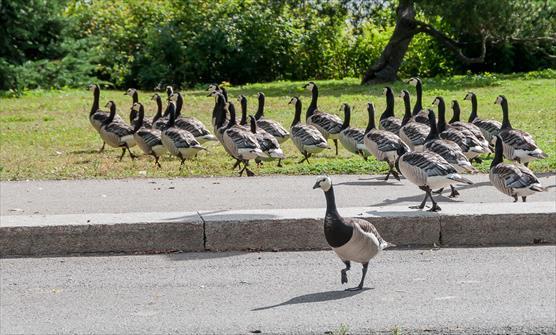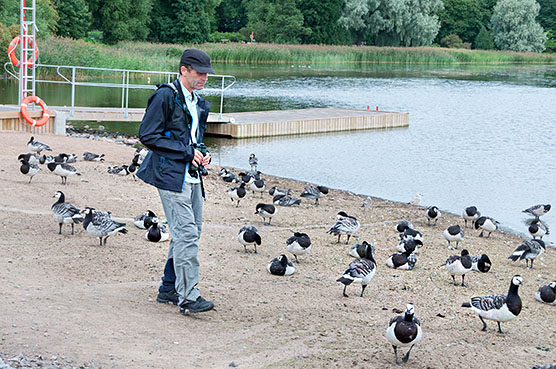Press release 2016-08-05 at 9:14

Photo Eija Putkuri.
The total number of barnacle geese grazing on the park lawns of Helsinki and eastern Espoo declined by four per cent compared to 2015. The number of goslings almost halved, declining by 46 per cent, compared to last year. This year, researchers from the Finnish Environment Institute (SYKE) counted a total of 5,720 barnacle geese, of which 484 were goslings.
In the census performed at the end of July, the largest barnacle goose populations in Helsinki were found in Arabianranta (614 birds), Suomenlinna (608), Töölönlahti (436) and Kaivopuisto (384). A total of 838 birds were counted in Espoo, most of which grazed in Otsolahti (431) and the eastern shore of Otaniemi (181). Espoo's share of the late summer barnacle goose population accounted for only 15 per cent, declining by nearly half when compared to 2015. In Seurasaarenselkä bay, the largest concentrations of geese were found on the Hietaniemi beach and along Merikannontie.
Number of goslings declined dramatically
In the Helsinki Metropolitan Area, the total number of broods (215 broods) declined by 171 compared to 2015. The average brood size was 2.3 goslings per brood, which corresponds to the average brood size recorded in 2006–2015. Likely causes of the decline include the increasing presence of white-tailed eagles, particularly in the outer archipelago, predation by large seagulls and urban foxes, as well as the rainy month of June combined with strong winds.
In Helsinki, the highest number of broods were observed in Suomenlinna (41 broods), Töölönlahti (26), Kaivopuisto (24) and Arabianranta (21). Töölönlahti's share of the total number of broods increased significantly compared to previous years. In Espoo, a total of 25 broods were found, the majority of which grazed in Otsolahti (10) and the centre of Tapiola (8).

The choice of grazing area is affected by the number of goslings
Barnacle goose broods typically graze in grassy areas close to the seashore. This year, the grassy areas surrounding Töölönlahti bay in particular became more popular among goose broods. The number of non-breeding adult geese counted was approximately 4,700, an increase of nearly 600 when compared to the previous summer.
At the time of the census, a number of old barnacle geese that had failed to nest and adolescent birds that have yet to nest at all were still staying out in the archipelago and along shores, which provide them with plenty of aquatic vegetation to feed on, such as pondweeds. Places like this included the area in front of Tullisaari (137 birds), the area in front of Hylkysaari (124), the areas around Munkkinemi (95) and Eläintarhanlahti (63).
Further information
Senior Researcher Markku Mikkola-Roos, Finnish Environment Institute (SYKE), tel. +358 (0)400 148 685, firstname.lastname@ymparisto.fi
Researcher Pekka Rusanen, Finnish Environment Institute (SYKE), tel. +358 (0)400 148 691
firstname.lastname@ymparisto.fi
Biodiversity & Communication Expert Riku Lumiaro, Finnish Environment Institute (SYKE), tel. +358 (0)40 509 8654, firstname.lastname@ymparisto.fi